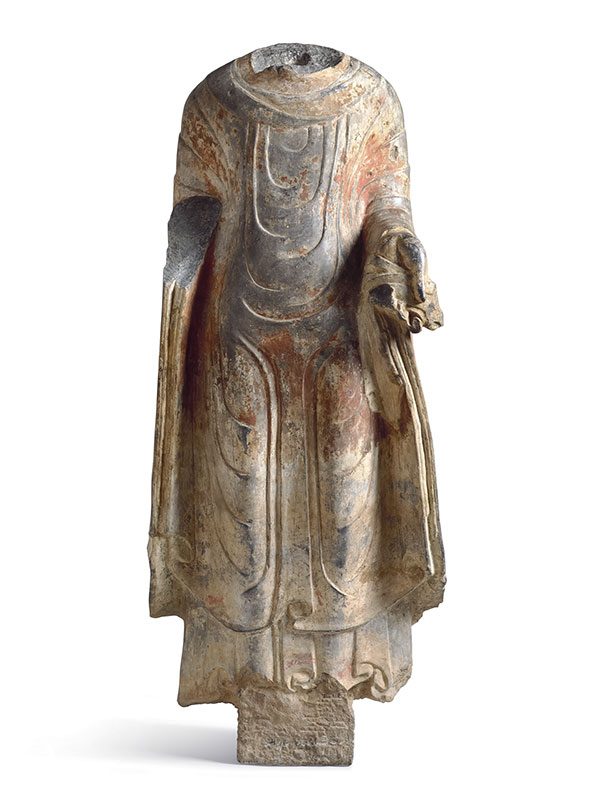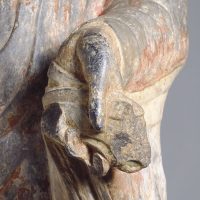Limestone torso
China, Northern Zhou dynasty, 557 - 581
A grey limestone standing torso of the Buddha. The left hand is raised to the waist with palm uppermost, grasping the end of the garment. The deity wears layered ankle-length robes that fall in stylized folds, forming deep U-shapes at the chest and over the thighs, with a central Y-shaped fold of material between the legs. The garment terminates in a fluidly undulating hem above the ankles with the underskirt emerging in thick pleats. The back is simply carved with a few curving vertical strokes indicating the fabric folds and with the furthest edge of the garment tossed over the shoulder and trailing down the back. The stone has a smooth patina and bears traces of the original red, green and white pigments, as well as some gilding.
The columnar, full-frontal quality of this magnificent, monumental torso places it within the Northern Zhou sculptural tradition. The Northern Zhou period is the last heyday for Chinese Buddhist art in the sixth century and many Buddhist grottoes were built back then. The style of Northern Zhou Buddhist figures is actually a mixture of the styles of the Eastern Wei and Northern Qi dynasties, combined with southern regimes and the Gupta style from India. In 574 AD Emperor Wudi of the Northern Zhou dynasty launched a three-year Buddhist persecution and as a result many Buddhist figures were destroyed at that time, making this Northern Zhou torso a very rare and precious survivor. The sculpture can be compared to a figure in the collection of the Shanxi Provincial Museum.[1] Another view of this figure is illustrated in the catalogue of this museum.[2] A closely comparable figure, also in the museum collection, has an inscription dating it to the 4th year of the Tianhe reign of the Northern Zhou period, corresponding to 569.[3]
Provenance:
Eskenazi Limited, London.
Private collection, the Philippines.
Exhibited:
London, 2004, Eskenazi Limited.
Published:
Eskenazi, Chinese Buddhist figures, London, 2004, number 1.
- Matsubara, S. A History of Chinese Buddhist Sculpture, plates volume 2, Tokyo, 1995, plate 367
- Shanxi Provincial Museum, Shanxi shidiao yishu, Beijing, 1962, number 23
- Shanxi Provincial Museum, Shanxi shidiao yishu, Beijing, 1962, number 22op. cit. no. 4:6, p. 136
北周/石灰岩菩萨身段
北周是北朝的最后一个政权,同时也是北朝佛教艺术的最后一个兴盛阶段,但由于武帝时期的灭佛运动,北周时期的佛像遗留甚少,尤为珍贵。1一句北周庾信铭文: “似刻浮檀,如攻水玉,从容满月,照耀青莲”的描述却足以说明北周时期佛造像的精美。北周的佛教造像广泛吸收了东魏、北齐、南朝政权以及笈多王朝佛造像的特点,风格多样,可见褒衣博带者,亦可见通肩大衣者。此尊造像为典型的通肩大衣制式,左手遗失,右手轻挽衣襟施“无畏印”。衣着层次繁而不乱,褶皱线条刻画与身量协调,整体呈现优美的“U_”字形。整体包浆厚重自然,仍可见红、绿、白等彩料残存以及贴金痕迹。
来源:伦敦艾斯肯纳齐画廊;菲律宾私人收藏
参展:伦敦艾斯肯纳齐画廊 2004 年度大展
出版:《中国佛教造像》,2004 年,No.1,伦敦,艾斯肯纳齐画廊。
1:张铭博士(Dr. Zhang Ming).麦积山石窟第4窟研究,The Research on Cave 4 of Maijishan Grottoes. 兰州:兰州大学,2017 年6 月博士学位论文


